by Heather Plett | Apr 8, 2016 | circle, Wisdom, women
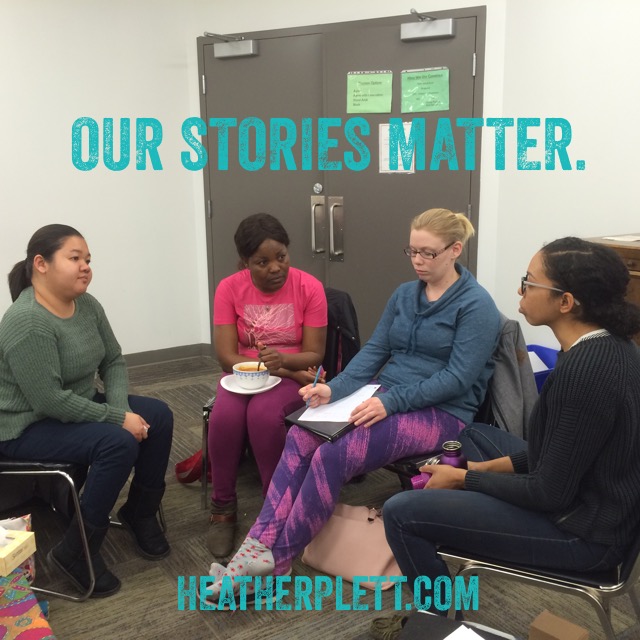
“How would you introduce yourself if you alone got to choose how you are defined?” That’s the question I asked a circle of women who’d gathered for an all-day storytelling workshop yesterday at a downtown women’s resource centre. “There are ways in which we’re expected to introduce ourselves – what we do for a living, where we live, what our marital status is, etc. – but today we’re going to choose an introductory question that let’s us choose our own definitions.”
The first question offered was the one we used as our check-in question. “How are you a survivor?”
It was a beautiful question and it opened the door for honest and vulnerable sharing. These women are fierce survivors. Some are refugees, some are Indigenous, some are single moms, and most are living in poverty. They have survived domestic abuse, mental illness, conflict in war torn countries, the birth and death of children, racism, hunger, and a multitude of other challenges. They are resilient and courageous and it was an honour to be in circle with them.
“We have a choice,” I said. “We could have told those same stories from the perspective of victims, and they would still be true, but we chose to tell them as survivors. That doesn’t mean we haven’t been victimized – we have – but we found ways to survive and now that’s the story we’re choosing to tell.”
“It matters that we claim our own stories,” I said. “Because our stories give us power. Our stories define us and help us to tell the world who we are.”
Later that morning, I showed the women a magazine spread from the in-flight magazine I’d picked up the day before. It was a three-page spread promoting New York magazine’s Best Doctor issue. Not surprisingly, the only images were of white, male doctors.
“When we see things like this again and again in the media,” I said, “we make the assumption that the best doctors are white males. Then, when we find ourselves hospitalized, and we end up with someone who’s not a white male doctor, subconsciously we come to the conclusion that our doctor is not one of the best.”
Whoever gets to tell the stories holds the power. And vice versa. When it’s largely white males who own the media, run the big companies, have access to political machines, and have the most influence in the world, they get to tell the stories their way. Their stories reflect people in the way that is most beneficial to them, and so they tell us stories of people who look like them.
When we hear almost exclusively the stories of people who look and live differently from us – whether it’s because of their gender, race, sexual orientation, class, physical appearance, etc. – we absorb the message that we have less value. And that’s when we become shameful of who we are and we stop telling our own stories. We stop believing that our stories matter.
“I used to be ashamed of who I was,” one of the Indigenous women in the circle shared with us. “When I was growing up, there weren’t many Indigenous kids in our neighbourhood and the only thing we ever heard about Indigenous people was that they were drunks or homeless or gang members. I was ashamed to say who I was, so I tried to pass myself off as Italian. It took me a long time to reclaim my own identity.”
Another woman, a recent immigrant from the Philippines, shared about the shame she’d felt when she’d left an abusive husband and had become a single mom. “I was blaming myself for getting myself into that situation. I shouldn’t have married him in the first place. I felt like everyone was judging me.”
“Our shame keeps us silent,” I said. “But when we start to share our stories, we release ourselves of that shame and then people can’t hurt us with those stories anymore. Those stories become part of our beauty instead of part of our shame.”
“Would it have made a difference if you’d heard more stories of people like you?” I asked both women. “Would it have helped you believe in your own value as Indigenous women or single moms?”
“Yes, when we see people like us doing good things, it makes us feel better about who we are. And when we see their courage, we believe that we can be courageous too.”
“That’s why our stories matter,” I said. “And that’s why we have to find creative ways to tell them. The people who own the media and the publishing companies aren’t going to give us much space to tell those stories, so we have to find alternative ways of getting them out to people who need them. We have to find ways of reaching the kids who were growing up just like you did, and the women leaving abusive husbands just like you did, so that they can see their own worth.”
I pulled out the in-flight magazine again, and this time I shared a story of a photo exhibit opening in Washington, D.C., called “She Who Tells a Story: Women Photographers from Iran and the Arab World” which brings together 80 stereotype-challenging, genre-defying works. “What’s striking about the works,” the article says, “is how they dispel the idea, put forth by the international media, that these women are homogenous and invisible. The photos are feisty, provocative, and, above all, thought-provoking.”
“These women chose to tell their own stories their own way,” I said. “Instead of waiting for someone to give them permission to tell their stories, they chose to own them and tell them the way they wanted to.”
We ended yesterday’s workshop by brainstorming creative ways in which these women could tell the stories of their people in their own neighbourhoods without waiting for the mainstream media to call.
Our stories matter. Our stories have power. When we tell them, we let go of shame and we give other people hope and courage.
*******
Learn to tell your own stories in the next online Openhearted Writing Circle on April 23, 2016.
*******
Interested in more articles like this? Add your name to my email list and you’ll receive a free ebook, A Path to Connection and my weekly reflections.
by Heather Plett | Nov 13, 2014 | Uncategorized
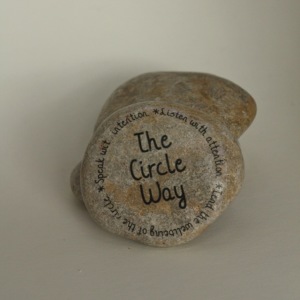 Not long ago, I taught a storytelling workshop in a corporate environment. As is the case with almost all of my workshops, we gathered the participants in circle and started by passing the talking piece and inviting each person to share one personal story. Since much of the work this organization is involved in is conservation-related, I asked them to share a story about something they enjoyed doing outdoors – either as a child or as an adult.
Not long ago, I taught a storytelling workshop in a corporate environment. As is the case with almost all of my workshops, we gathered the participants in circle and started by passing the talking piece and inviting each person to share one personal story. Since much of the work this organization is involved in is conservation-related, I asked them to share a story about something they enjoyed doing outdoors – either as a child or as an adult.
When the talking piece (a simple stone with the organization’s logo on it) had almost completed the circle, one of the last people to hold it said “Is this talking piece magic or something? I now know more about the people in this circle than I’ve known in all the years I’ve worked here!”
When the stone came around to me, I spoke to his comment. “No, it’s not magic in and of itself. It’s just an ordinary stone.” I said. “What IS magic, though, is the way that the talking piece invites us to listen in ways we don’t normally listen and speak in ways we don’t normally speak.”
When a talking piece goes around the circle, only the person holding it speaks. Everyone else is silent and attentive. Even though you may be tempted to interject – to offer advice, another version of the story, or your own story to top what’s been said – you must wait until the stone circles around to you before you can speak. By then, your need to interject into someone else’s story is usually silenced and you speak instead from your own story.
What results is a space where each story is heard in its entirety without crosstalk, correction, or advice.
That’s a powerful notion. It doesn’t happen often in our day-to-day conversations. Pay attention the next time you are chatting with your friend, partner, child, or parent. Do you listen to their WHOLE story without interrupting? Do you let them share sad moments without rushing to fix them? Do you honour their story with attentive listening?
Brene Brown teaches that our need to fix other people is our own “defense against vulnerability”. In other words, when you share something hard with me and I am quick to offer advice on how to resolve that hard thing, I’m doing so because I don’t want to be vulnerable, I don’t want to enter into that hard place with you, and I don’t want to admit that I don’t have all the answers.
Peter Block went even further in a talk I heard him give a few years ago. “Helping is an act of violence,” he said, and then went on to explain that our efforts to help other people are often unwelcome attempts to change or fix something they haven’t given us permission to change. By fixing a problem we haven’t been invited to fix, we are violating that person. Instead we must learn to sit with them in the problem while they work to find their way through.
“Speak with intention. Listen with attention.” That’s what The Circle Way teaches us. It doesn’t say “listen in order to fix” or “listen only until you have a chance to interject” or “speak with the purpose of outshining everyone”.
When I sit in a circle with a dozen other people, I need to be prepared to listen 12 times as much as I talk – even when I’m the teacher. And when I am listening, I need to do so in attentive silence, holding their story as sacred and valuable rather than as something that needs fixing.
The more I practice The Circle Way in my work, the more it is influencing the way I interact with people in my life. I don’t get it right all the time (just ask my daughters or husband!), but I’m a work in progress.
If you want to bring the circle into your own life, here are a few things to consider:
- The next time someone shares a story with you, whether in person or on Facebook, honour their story with intentional listening. Pretend they’re holding a talking piece and wait your turn.
- Do not offer advice unless it’s been specifically requested.
- Do not try to smooth over someone’s grief or pain with platitudes about how it will get better. Just be present in the moment with them.
- When you gather with friends or family, try passing a talking piece (anything can be used – I’ve used pens, leaves, sticks, and even a small statue in the spur of the moment) so that each person’s story can be heard.
Want to know more about The Circle Way? Ask me! I’m part of an international network involved in this work, and would be happy to talk about upcoming workshops that I and/or my colleagues are offering.
by Heather Plett | Apr 3, 2014 | Uncategorized
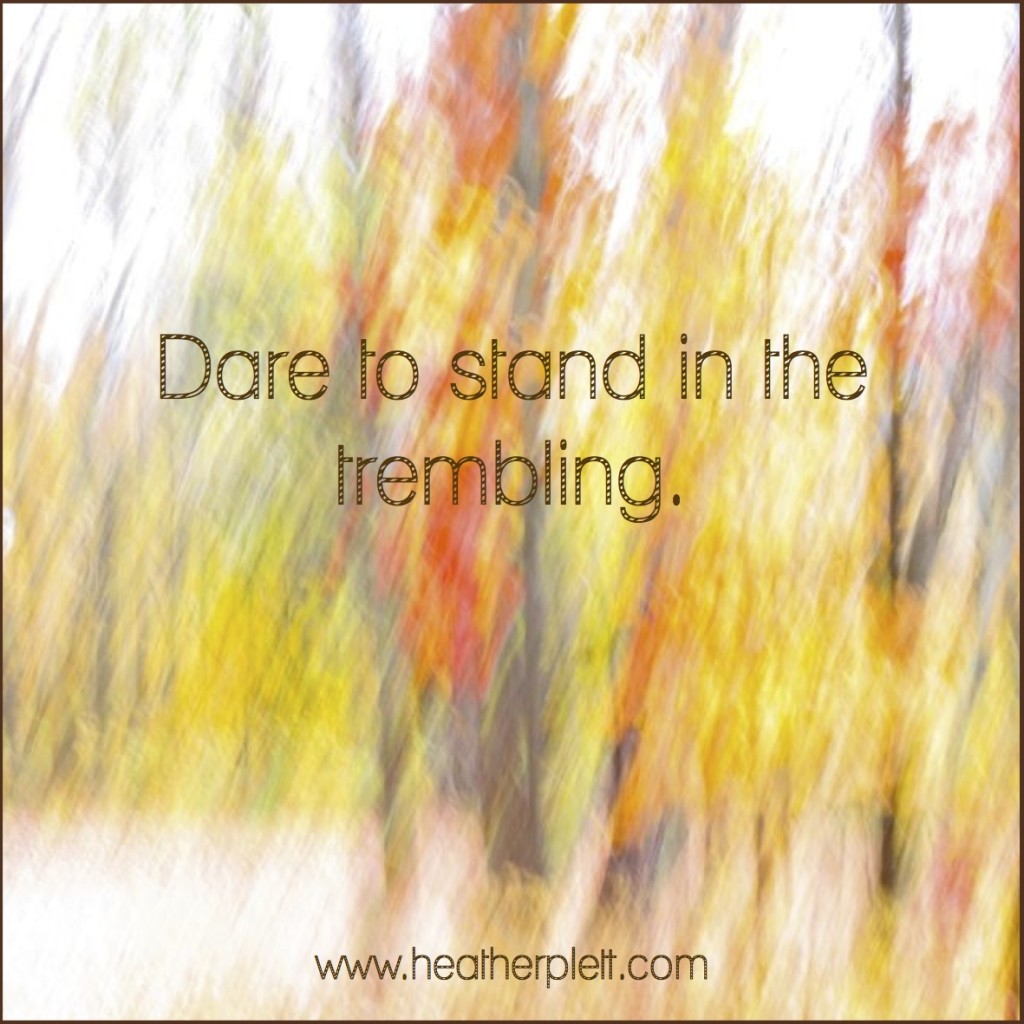 A dozen years ago, I taught my first class on creativity and spirituality. A small circle of women gathered each week to give themselves permission to play, to explore creativity as a spiritual practice, and to exhale deeply.
A dozen years ago, I taught my first class on creativity and spirituality. A small circle of women gathered each week to give themselves permission to play, to explore creativity as a spiritual practice, and to exhale deeply.
Each week, with our hands in clay or paint, we cracked open the vulnerable places in our hearts that held the shame of our unworthiness, the fear of our failure, and the resistance to allowing ourselves to do that which brought delight.
Almost every week, I found myself in the middle of “the trembling”. I’d spent most of my life ignoring my body, so I didn’t recognize at the time that it was sending me powerful messages. As I’d host the women’s stories of heartbreak, fear, shame, and triumph, my whole body would begin to tremble, like it was shivering from cold. I’d have to clench my jaw sometimes, or hold my hands under the table, afraid my shaking might be seen.
At first, I chalked it up to nervousness. This was brand new work – work I’d been longing to do for years – and I didn’t know if I would succeed.
But it wasn’t nervousness (or at least it wasn’t only nervousness). I’d done much scarier things in my career (like hosting press conferences for Prime Ministers) and none of those scary things had caused the shakes like that.
In the words of Mihaly Csikszentmihalyi, the trembling came in those moments when I was in flow… “completely involved in an activity for its own sake. The ego falls away. Time flies. Every action, movement, and thought follows inevitably from the previous one, like playing jazz. Your whole being is involved, and you’re using your skills to the utmost.”
This was so much more than nervousness. This was the message my body was sending me that I was in my right work.
That class led to other classes, to other circles, to other soulful conversations, to other art-making, and to other work that made my body vibrate. It was the beginning that eventually lead to everything I do now.
The trembling showed up again and again, while working with coaching clients who dare to crack their hearts open, while hosting women’s retreats where tears reveal the most honest truths of the heart, while inviting corporate clients to risk exposing themselves in meaningful conversations, and while writing blog posts that come from a deeper place of knowing than anything I’ve tapped into before. The trembling tells me I am on the right path, doing the right work, talking to the right people.
When I hosted the first call for the Idea Incubator, I invited people to share where in their lives they are feeling the trembling. As they shared what was cracking their hearts open, I felt my own trembling begin again. This is my work. These people with open hearts and brave dreams are my people. I stand here, trembling with them.
What if, the first time it showed up, I’d simply interpreted the trembling as fear and learned to shy away from it in the future? What if I’d never taught another class because I was too embarrassed to be seen with shaking hands? What if I’d been careful to stay in work that never made me tremble?
What if YOU ignore the trembling? What if you take the safe road? What if you never dare to let yourself be scared? What will you miss?
The trembling is our messenger. It’s trying to get our attention. It’s trying to wake us up and point us in the direction of our hearts’ longing.
Don’t ignore the trembling.
by Heather Plett | Oct 9, 2013 | Beauty, circle, Compassion, Uncategorized
I am carrying a huge basket of stories that I gathered on my trip. Each day I added new stories emerging from the deep conversations I had with people in my travels through Reno, Lake Tahoe, Oakland, San Francisco, Atlanta, Asheville, and finally Lake Lanier. I want to share all of those stories with you, but some of them need to ripen in the basket a little longer before they’ll be ready to be harvested.
First of all, let me tell you that this trip was all about love. Here’s what I posted on Facebook when I first got home…
After all of my travels in five states, after all of the deep and soulful conversations, after the early morning sunrises over the lake, after the sharing circles, after the ziplining, after the skinny-dipping, after the wandering in the woods, after the cracking open of many hearts, after my talk about the courage to lead differently, after bountiful feasts from the hands of many farmers, after the laughter, after the tears, after the deep body hugs and the tenderhearted kisses… after it all fades into memory, my learning can be boiled down to the words on the mug I brought home… Love more. Love fiercely and deeply. Love courageously. Love ridiculously. Love the sky and the earth and the dogs and the caterpillars. Love the wine and the music. Love the brave hearts and the fearful hearts. Love the ones that are easy to love and those who are more difficult. Love with wild abandon. Love until your heart cracks wide open and we all see the fleshy softness inside. Love more and let yourself be loved. Don’t be afraid of love.
It might sound rather pie-in-the-sky, but it’s the ground on which I stand. Love is what let me go on this journey when so many of you supported this dream. Love is what let me connect with beautiful people all along the way. Love is what inspired me to share from my heart on stage. Love is what gave me the courage to believe I had something to share. It’s all about love.
Almost as soon as I got home from my journey, reality smacked me across the face. There’s a huge crack in our basement wall that will probably cost us thousands to fix, my aunt died of brain cancer while I was away and her funeral was yesterday, I’m dealing with a nasty bug bite that I got in Atlanta that seems to be infected and I spent yesterday evening in urgent care, and there’s a little heartbreak in my relationship with one of my daughters. Any of those things individually could have sent me into a tailspin of despair, but they didn’t. I’m okay. I’m more than okay. I am feeling strong and courageous, and – more than anything – loved.
LOVE has made me resilient. LOVE has given me courage. LOVE has given me hope.
At Patti Digh’s Design Your Life Camp at Lake Lanier last week, Maya Stein and Amy Tingle did something so breathtakingly beautiful and full of love, I found my heart breaking wide open. First of all, they’d brought their vintage trailer MAUDE (Mobile Art Unit Designed for Everyone) along to camp and they were inviting everyone to visit to make art tags to hang in a tree. Secondly, they each had vintage typewriters, and if you offered them a single word, they would each write a spontaneous poem on an index card made especially for you. They did both of these things with beauty, grace and generosity, not asking to be paid or flaunting their brand in anyone’s face – simply offering this gift to anyone who would receive it.
The first time I saw them with their typewriters, I felt a little overwhelmed – not sure I could step forward and feel worthy enough of the gift. I was intrigued, but it felt somehow vulnerable and tender to give them a word and then simply receive. I had already received so much on this journey (and even before the journey in order to make it possible) that the gremlins were saying “You’ve received enough. You had the AUDACITY to ask people to help pay for this trip. How DARE you think that you are worthy of another gift?”
When I came out of the session the next evening, though, and saw them with their typewriters again, I knew I just had to do it. I knew I was worthy. I knew, deep down in my bones, that I wanted this gift and was ready to receive it.
I stood in line and waited… and agonized over what word was the right one. I wrote one word down, but then it didn’t feel right, so I scratched it out. Just before I got to the front of the line, I knew what my word was. Resilient.
Resilient is how I feel these past couple of months as I emerge into my work in a bigger way after the hard, hard year of losing Mom, watching my husband have a heart attack, breaking my foot, and then finding out my brother has stage 4 cancer. Resilient is what I’ve been in the past, after losing dad very suddenly, having a stillborn son, and watching the man I love wrestle with depression so powerful he attempted suicide twice. Resilience is one of my strengths and it’s one of the gifts I give to my clients in this work of being real and courageous and hopeful in this broken world.
And so I stood there, tenderly and anxiously, waiting to see what they’d do with the word resilient.
What emerged floored me and broke me open.
Here’s what Amy wrote:
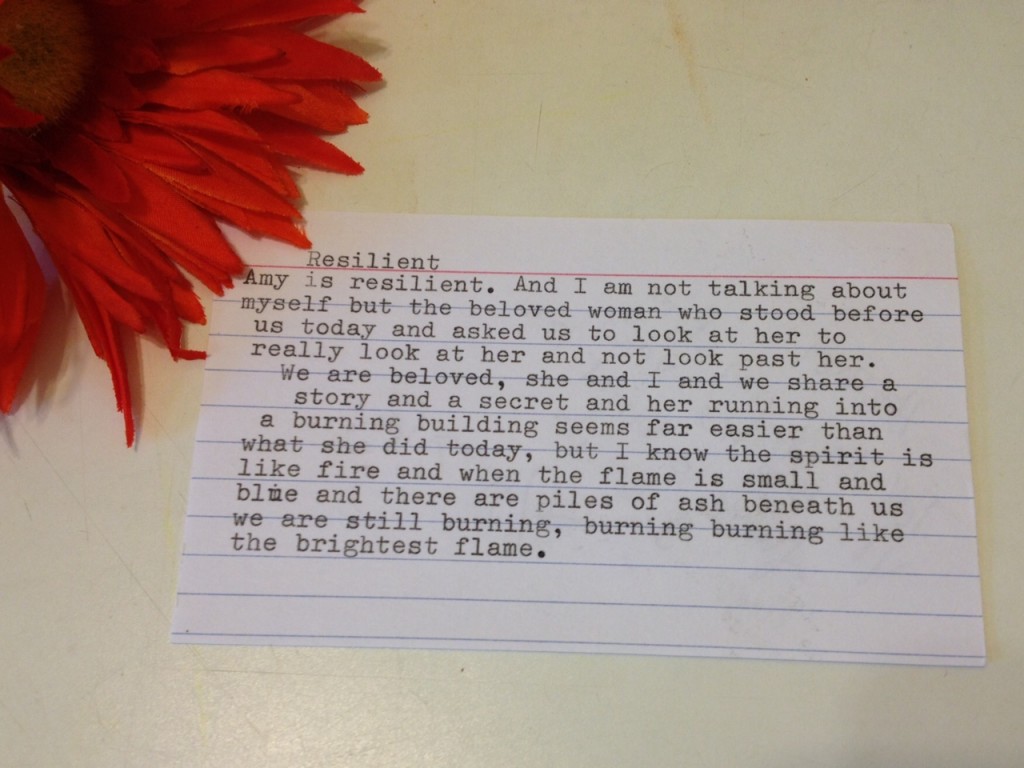 The Amy she mentioned is Amy Dier, who had just shared a very personal story from the stage about learning to love and trust herself and allow herself to be seen. She was a former police officer who’d gone into law enforcement partly because she’d been raped when she was a teenager. She said she’d only shared the story of her rape with 8 people before saying it aloud in this room full of 150 people. After sharing the story, she invited us all to stand in a circle and she walked around the circle, looking into our eyes, and saying to each of us one at a time “I see you.”
The Amy she mentioned is Amy Dier, who had just shared a very personal story from the stage about learning to love and trust herself and allow herself to be seen. She was a former police officer who’d gone into law enforcement partly because she’d been raped when she was a teenager. She said she’d only shared the story of her rape with 8 people before saying it aloud in this room full of 150 people. After sharing the story, she invited us all to stand in a circle and she walked around the circle, looking into our eyes, and saying to each of us one at a time “I see you.”
What Amy the poet had no way of knowing was that Amy Dier and I do indeed share a story or two – the story of surviving rape, as well as the story of learning to believe we are worthy of being seen.
The second poem, from Maya, was the perfect addition, in a way that neither poet could possibly have known. The day after I was raped by a man who climbed through my bedroom window, I was supposed to take part in a triathlon relay race. I was going to ride 40 kilometres on my bicycle, while others did the running and swimming legs. This felt like a courageous and fierce act for me at the time, given the fact that I’d never believed I was athletic enough to be in any competition of that sort.
The day after I was raped by a man who climbed through my bedroom window, I was supposed to take part in a triathlon relay race. I was going to ride 40 kilometres on my bicycle, while others did the running and swimming legs. This felt like a courageous and fierce act for me at the time, given the fact that I’d never believed I was athletic enough to be in any competition of that sort.
I never completed that bicycle ride. My body was too sore after the abuse it took at the hands of the rapist. Plus I felt a strong urge to drive home to the farm to be with my Mom and Dad.
But that doesn’t mean I didn’t get back on the bicycle, again and again and again. My whole life has been an act of getting back on that bicycle, each time I fall down. Through all of the deaths, disappointment, and tragedy in my life, I keep getting back on my bicycle – both literally and figuratively. (Ironically, I was actually on my way into the garage to go for a bike ride with my daughter when I broke my foot in Spring. Another metaphor, perhaps?)
And that brings me back to love. I get back on my bicycle because of love. I stay in a marriage that has been challenging because of love. I keep showing up for funerals because of love. I drive across the country to be with my brother after cancer surgery because of love. I sit beside my mother and watch her die because of love. I show up for my teenagers even when they’re snarly because of love. I travel across the country and sit in circle with myriads of beautiful people because of love. I coach my clients and host retreats because of love.
I do what I do because I have been given a lot of love and because I have a lot of love to give.
I pour love into everything I do. And love is what sustains me and gives me courage for this work. Because love is worth it. Love has made me who I am, and that is a beautiful thing.
The next time you need courage or resilience, remember that it starts with love. Give love and receive it and you will be able to get back on that bicycle, no matter how many times you fall.
Go ahead, love more.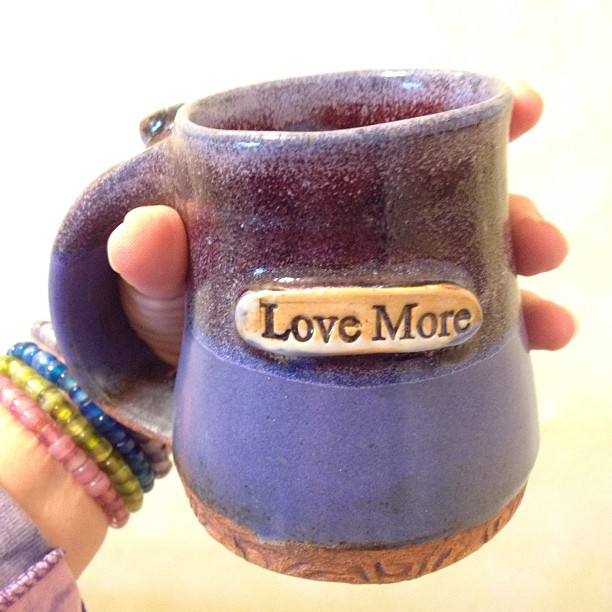
by Heather Plett | Aug 21, 2013 | Community, Spirituality, Uncategorized
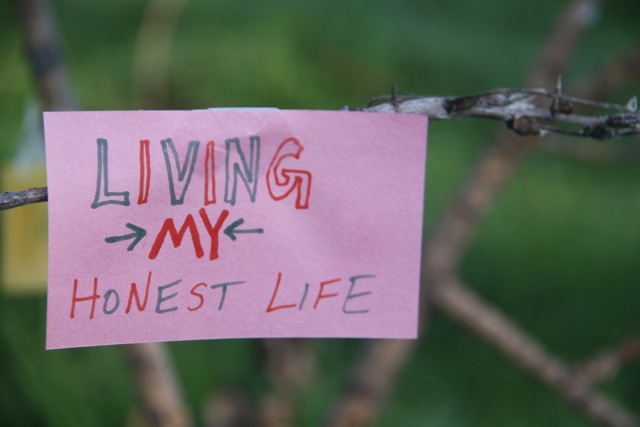
I am spiritual. That’s no surprise to you if you’ve been reading this blog for any period of time.
But it might be a surprise to you that I haven’t always been comfortable being “out” about my spirituality.
For starters, I was raised in a fairly conservative evangelical Mennonite family where faith was fairly black and white and you didn’t walk labyrinths, make prayer flags, take Buddhist meditation classes, pray to the Divine Feminine, embrace other faith perspectives, or talk about the way God speaks through a deer or a tree.
When I started exploring those things, I was afraid of rejection, and so I kept most of my exploration secret. There was a little too much fear of going to hell if you “worshipped false gods” in those circles, and that fear lingered deep in my own psyche long after I thought I’d dealt with it. I still don’t talk about it very much in some circles, and to be honest, I’m still excavating some of my rejection and fear stories around that. (I still consider myself a Christ-follower, by the way, but my understanding of what that means has shifted dramatically.)
For another thing, I spent a lot of years in the corporate world where any talk of spirituality was strictly taboo. Though I sometimes thought that my staff or the management teams I was on might be better off if we brought mindfulness and more spiritual openness into what we did, I wasn’t confident enough in my own exploration yet to introduce it. Again, it was mostly fear of rejection that kept me silent.
When I quit my job and started my own business, I started out as a split personality, still trying to keep my spirituality mostly in the closet. I had two websites – one was the polished, corporate-looking one I showed potential clients and students in my university classes, and the other was the blog where I explored the things that mattered most to me, including spirituality. Every time someone from the corporate/university world found the blog, I cringed a little, worried that they would no longer take me seriously as a consultant or teacher. There is, after all, an assumption in our culture that being spiritual means that you’re less intellectual and probably a little weaker than others.
About a year and a half ago, I started to realize that maintaining these two public faces was creating angst for me and making me feel disingenuous. After a couple of failed consulting gigs, I realized that I really didn’t want to work with clients who wouldn’t be comfortable with my spirituality. After trying to be something in the classroom I really wasn’t, I realized that my best teaching happened when I was authentically me.
And so I came out. I combined my blog with my website, integrated my spirituality into my consulting/facilitation/teaching work, and got used to stepping into a classroom where students and administration might think me a little “flakey or too woo-woo”.
I can’t tell you that it magically brought me all of the “right” kinds of clients (it’s still a gradual process), but I can tell you that things started to shift. In the very first class I taught after deciding to be more open and sharing my blog with students, I had four students approach me individually, interested in coming to me for coaching because they were looking for something deeper than they could receive in a classroom. And I started to get invitations to do amazing work that fits me perfectly, like the week long artists’ retreat I facilitated last week in Saskatchewan.
Yes, my work has shifted, and I’m sure a few corporate clients have been turned away by language that feels uncomfortable for them, but that’s okay.
More and more, my work is a true expression of who I am, not just the skills I can offer. More and more, I am bringing the full basket of my gifts and wisdom into what I offer.
And the right people are showing up. Almost all of my coaching clients, for example, share stories of how they too are trying to live more authentically and more boldly in a world that expects them to be more “corporate, straight, conventional, unemotional, etc.” They show up with their own fear of rejection stories and I can truly say “I see you.” And in the last six months, I’ve had the opportunity to host half a dozen retreat/workshops that are all about connecting on a deeper, more spiritual way. Again, I am more prepared to host them because I have been on my own journey to this deeper, more authentic place.
Another interesting thing has happened. Some of the people whose rejection I feared are coming forward and saying “Your work resonates with me. I’m curious about labyrinths/mandalas/etc. Can you tell me more?” My own “coming out” is encouraging others to be more honest about their own questions and exploration.
What about you? Do you sometimes feel like a fraud because you’re hiding the titles of the books you read from your colleagues at work? Do you take meditation classes in secret because you don’t want your family to know? Do you furtively read blog posts that make your heart sing, but you’re quite sure nobody in your world would understand? Do you feel like one of my clients, who said she is “kind of a weirdo, but in a good way”? Have you despaired of finding a circle of people like you who have questions that most people think are too “out there”?
You will need to find your own path through this, but you don’t have to do it alone. There are more of us spiritual seekers out here in this big world than you might imagine. Trust me – when I started being more open about my quest, I started connecting with a lot of amazing people who, like me, want to dive into meaningful conversations that go far beyond small talk, straight to the heart.
Here are a few thoughts on how you can begin to move into a more integrated, authentic life:
- Start small. Find at least one person who feels like a safe space to talk about your quest. This might be someone you already know and trust, someone at a yoga class, or a coach like me. Before you start the conversation, though, be sure that the person you’re talking to can respond in a non-judgemental way. If you face judgement in your very first conversation, your authentic you will run further into hiding.
- Find a place where you can be true to yourself. This might be your journal, a secret place in the woods, your favourite coffee shop or bookstore, or your art studio. In that space, commit to being totally honest with yourself about who you are and what you seek in the world. Read the books you want to read, write the truth that longs to be said, and dare to stand in awe of an eagle that seems to have a message just for you.
- Find a practice that connects you with your spiritual Self. There are many options – yoga, dance, meditation, walking, running, painting, mandala-making, etc. Do something that brings you peace and leaves you feeling connected to that authentic part of you that’s been buried under other people’s expectations.
- Practice truthfulness one tiny step at a time. If you are feeling inauthentic at work, find a least one co-worker whom you trust who won’t laugh at you when you admit to going on a meditation retreat. If that feels safe, take another step. You may be surprised to find other secret questers longing for the same conversation.
- Consider your priorities. If your steps to being more authentic at work feel unsafe or leave you feeling judged, consider how important it is to stay there. Is it time to walk away? Are you living a lie if you stay there?
- Recognize that some people will never “get it” and that’s okay. Some people might suggest that you should walk away from anyone who rejects your version of a spiritual quest, but life is far more complex than that. If a family member, for example, doesn’t understand it, then find other topics to talk about in their presence. You don’t need to lie to them, but you also don’t need to reveal your deepest heart to everyone in your life.
- Find community where you feel safe. With the internet making long distance relationships more and more accessible, it has become easier and easier to find circles where you can talk about your questions and spiritual quest. I wouldn’t say that virtual circles replace in-person relationships, but it’s at least a place to start. For example, many of the people who sign up for Lead with Your Wild Heart say that one of the best things about the program is the fact that they no longer feel alone in their quest for authenticity.
- Read a book or two that helps you understand your own quest. A few recommendations: Falling Upward: A Spirituality for the Two Halves of Life, A Hidden Wholeness: The Journey Toward an Undivided Life, The Seeker’s Guide: Making your Life a Spiritual Adventure, and What We Talk About When We Talk About God.
In all that you do, remember this – this journey is a long one. You don’t get to authentic overnight. It took me many years to realize some of the places I was living a divided life, and I know that there are still more realizations to come.
Take the journey one step at a time, and find companions along the way.








